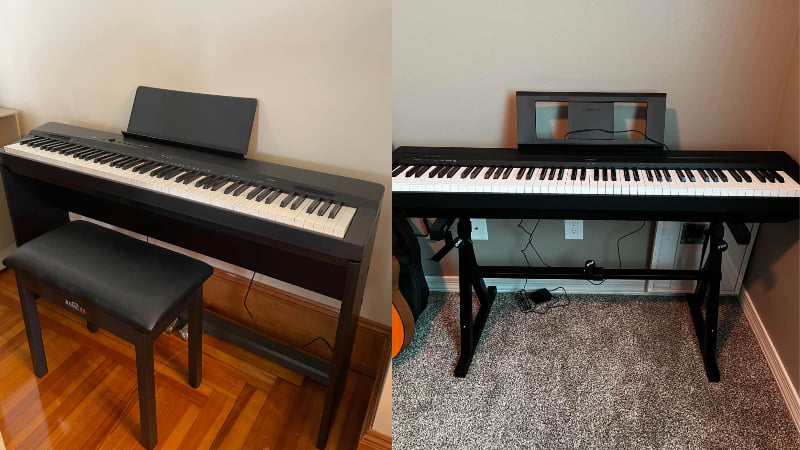For most pianists, the Yamaha P71 vs Casio PX-160 debate is one of the most interesting out there. Since they are arguably two of the best beginner pianos on a budget available today, they are constantly mentioned in the same breath. And after comparing the two head-to-head, I found that the Casio PX-160 is the better option.
With more tones, a more accurate feel, and a wide range of effects, the Casio PX-160 has everything a beginner needs and more. If you’re on the hunt for a beginner piano for you to start your lessons, this is a great pick.
With that said, the Yamaha P71 offers a wide range of benefits too. It has an unbeatable tone in its price range, a couple of different playing modes, and great app integration to make it easier to tweak settings and learn how to play the piano.
Yamaha P71 vs Casio PX-160: Comparison Chart


Last update on 2025-07-10 / Affiliate links / Images from Amazon Product Advertising API
Yamaha P71 vs Casio PX-160: Differences
When writing this comparison, I figured that the best way to choose a winner is by comparing the features against each other. And after the comparison, I found that the Casio PX-160 beats out the Yamaha P71 by 4-2. The wider sound library, superior feel, and the great sound system built into the Casio PX-160 made it the more versatile and better pick between the two.
Feel & Playability
The winner: Casio PX-160
The casio PX-160 was the clear winner when it comes to feel and playability. The scaled hammer action and coating on the keys made it feel like playing an acoustic piano, which is a very valuable feature for any pianist out there.
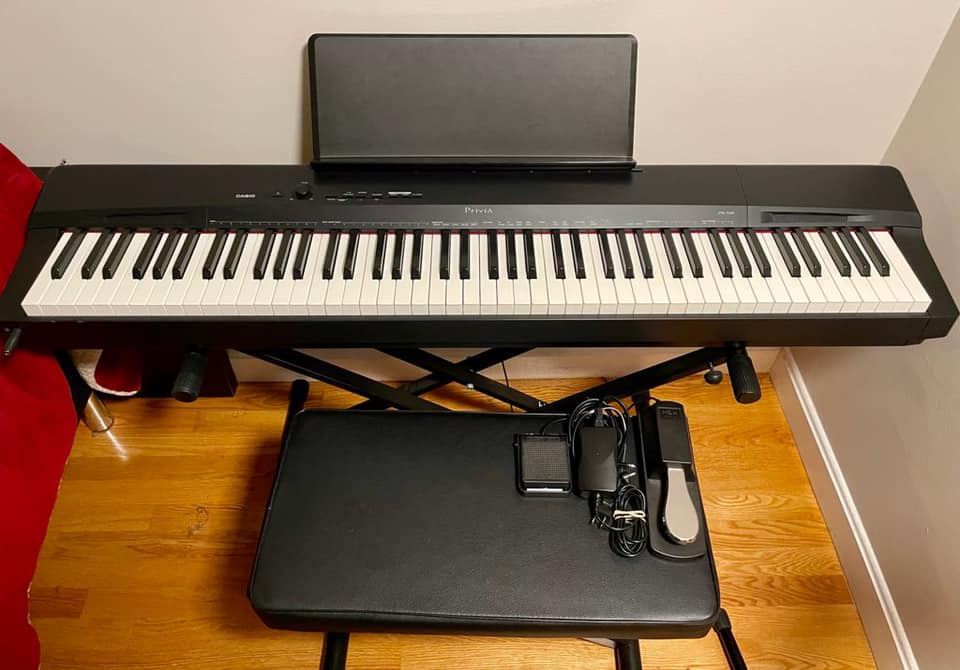
Hammer Action
Both the Yamaha P71 and Casio PX-160 feature scaled hammer action. This is meant to mimic how it feels to play an acoustic piano, where the keys on the left side are heavier and get progressively lighter as you climb up the piano. Both of these pianos do this very well, and when playing both of the instruments, the weight really feels like what you’ll find on an acoustic piano.
The Casio PX-160 uses the Tri-Sensor scaled hammer action, which provides a very realistic feel. Sadly, the Yamaha P71 doesn’t use Yamaha’s signature Graded Hammer System (GHS) on the keys, so the weight isn’t as realistic as the PX-160 or even other Yamaha models on the market.
Key Texture
The main reason I chose the Casio PX-160 as the winner in this regard is because of the key texture. The Yamaha P71 features plastic keys with no coating whatsoever to mimic ebony and ivory keys. The result of this is a very plastic-like feel on the keys, which isn’t too noticeable for beginners, but if you’ve played on multiple acoustic pianos before, the difference is glaring.
The Casio PX-160 features a coating on the keys to mimic ebony and ivory. This makes the keys feel much more natural and close to an acoustic piano. Granted, the coating could still be better, but it easily beats out the Yamaha P71 which doesn’t have a coating at all.
Tone
The winner: Tie
Comparing the tones of these two pianos had me split down the middle. While the Casio PX-160 offered a wider sound library with a bunch of different tones, the Yamaha P71 uses more advanced tone generation. So, since the Yamaha P71 has better quality tones and the Casio PX-160 offers more variety, they are tied when it comes to this feature.
Tone Generation
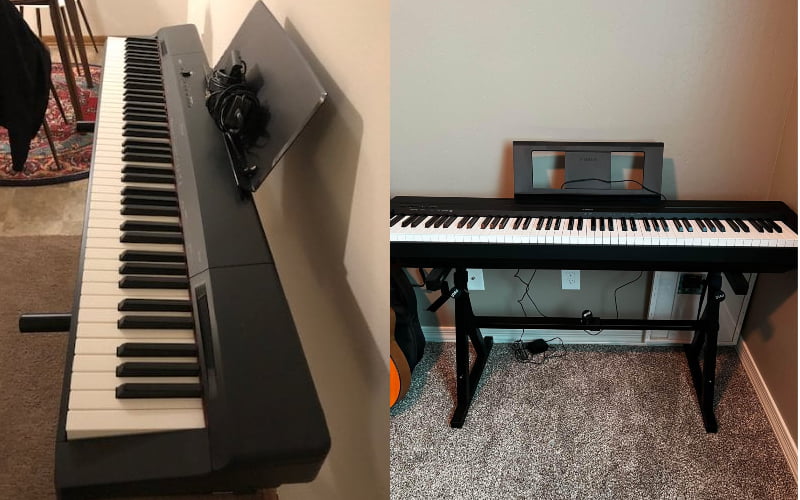
Both of these pianos use the traditional sampling method to generate tones. However, both pianos offer a modern twist to the method. On the Casio PX-160, you get the AiR technology. This method provides greater memory on the piano so that Casio could load higher quality samples with a more natural decay.
On the Yamaha P71, you have AWM or Advanced Wave Memory. This method samples the best Yamaha pianos and other famous grand pianos with natural decay and a digital filter so it sounds more realistic.
While the tone generation techniques are similar, I found that the Yamaha P71 offers brighter and crisper tones. While tone is a very subjective thing, there are many other pianists who agree with me in saying that the Yamaha P71 offers generally better tones than the Casio PX-160.
Sound Library
The reason these pianos are tied when it comes to tones is that the Casio PX-160 offers way more voices and options than other pianos in its range. The Yamaha P71 comes with 10 preset voices, which is already considered a lot of an entry-level digital piano. With these 10 voices, you have a range of electric and grand piano voices, along with some string, synth, and bass options which is more than a beginner needs. This gives you a lot of room for experimentation and a lot of sonic diversity.
However, the Casio PX-160 comes with 18 different voices. In its range, this digital piano has one of the richest and most-packed sound libraries out there. It contains the same kinds of tones as the Yamaha P71, just with more options and variations with which you can experiment. If you play with other musicians or want to record your own music, the Casio PX-160 is a great option as it gives you a whole lot of musical versatility.
Piano Features
The winner: Tie
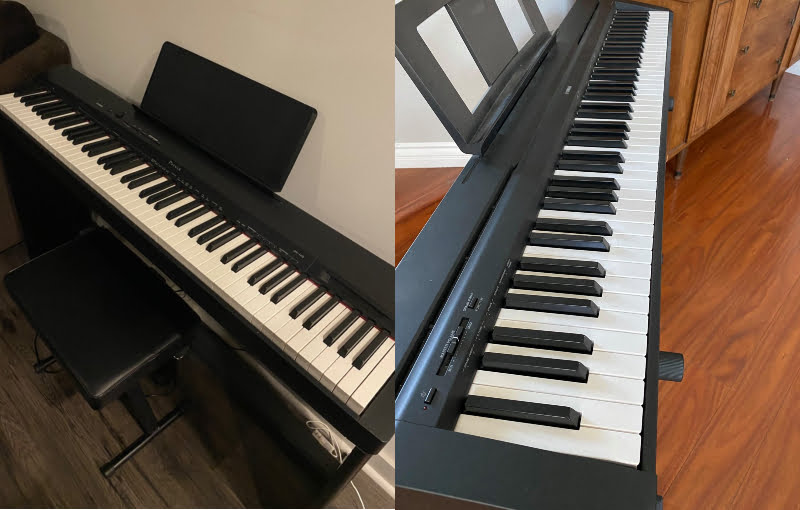
Another area where these two pianos are definitely tied is when it comes to piano features. Both come with a pretty good range of effects, playing modes, and connectivity features. Considering that these are some of the best beginner pianos on the market today, it’s no real surprise that they come with robust features.
Polyphony
The only piano feature where these two options aren’t tied is polyphony. The Yamaha P71 has 64 note maximum polyphony while the Casio PX-160 has 128 maximum polyphony. While 64-note polyphony is more than enough for beginners, you might run into some trouble when playing dense notes with the sustain pedal engaged.
On the flip side, with the Casio PX-160’s 128 note maximum polyphony, you have more versatility while playing, which is a very valuable feature as you get better at the instrument and start applying more advanced techniques.
Playing Modes
Both the Casio PX-160 and the Yamaha P71 come with duo and dual mode. These are two great features to have if you’re a beginner as it makes it easier to go through piano lessons while also giving you room for experimentation.
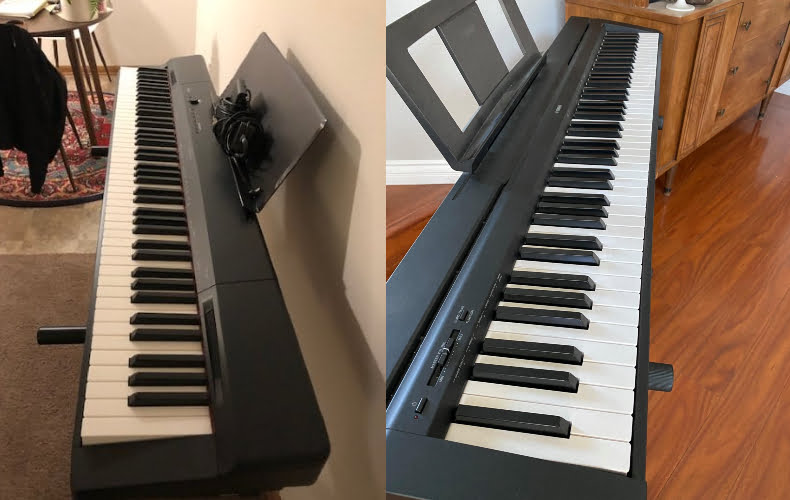
With duo mode, you can divide the piano into two smaller keyboards with the same pitch and voice. This allows the student and teacher to play along together with the exact same notes without having to cross over each other. This also allows the teacher to demonstrate certain techniques and music without using the other side of the piano.
Dual mode, on the other hand, allows you to blend two different voices. This is a great feature if you’re experimenting with different sounds or playing as an accompanist and need richer tones. This isn’t exactly a necessary feature as most beginners won’t use it that much, but it’s a very nifty feature to have.
Effects
In terms of effects, both of these pianos have some great options. The Yamaha P71 comes with 4 different types of reverb, which is really the only effect you’ll need as a beginner. This allows you to achieve a fuller sound when playing and mimic the natural reverb of a grand piano in specific venues like concert halls.
The Casio PX-160 offers more effects than the PX-160. On top of the reverb, you also have chorus effects and brilliance control. These are great if you are particular about your sounds, as you can tweak the settings and get the piano to sound exactly how you want.
Connectivity & App Integration
One of the areas where the Yamaha P71 beats out the Casio PX-160 is with its connectivity and app integration. While both pianos support a USB connection, the Casio PX-160’s connection is only for transferring files and songs. On the flip side, you can use the Yamaha P71’s USB port to connect to a computer or smartphone and access Yamaha’s partner apps. Through these apps, you can learn different songs, tweak different settings on the piano, and more!
Sound System
The winner: Casio PX-160
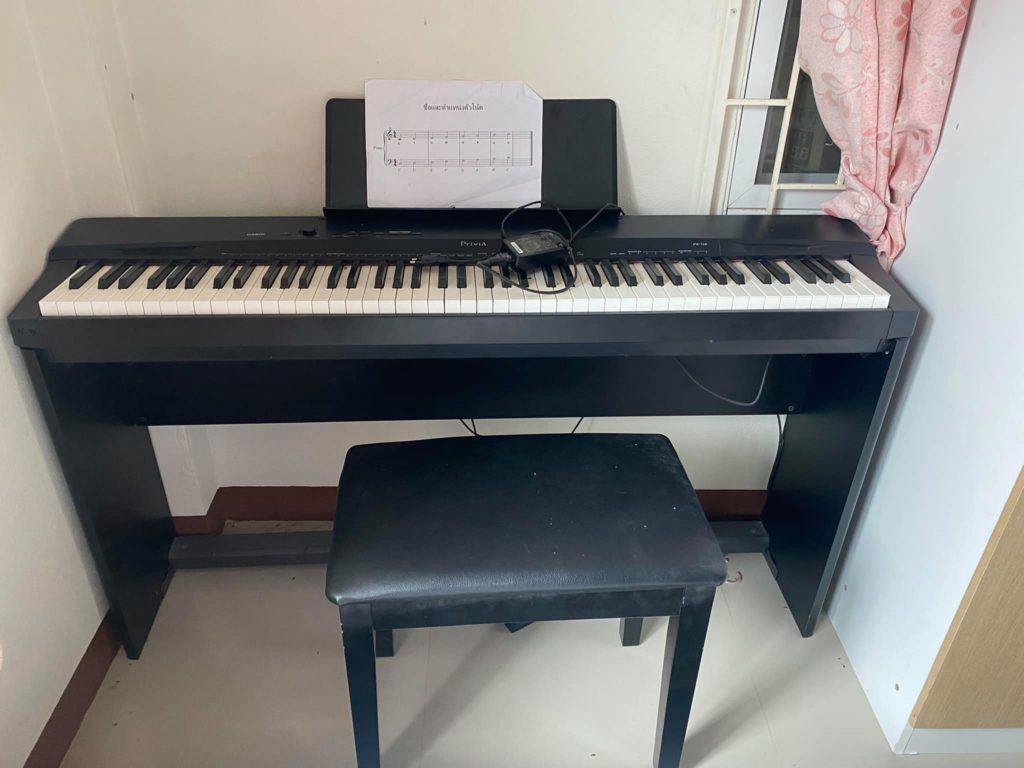
The Yamaha P71 has a lackluster sound system. With two 6W speakers, you don’t exactly get the loudest sound. However, if you’re just practicing at home or jamming with a couple of friends, the built-in speakers are more than loud enough. However, for performances, you’re going to need to plug into an external sound system.
The Casio PX-160 has two 8W speakers, which aren’t that much better, but they are significantly louder. They still aren’t loud enough to perform without connecting to an external sound system, but it’s easier to be heard when playing and jamming with other musicians. So, while the Casio PX-160 wins this category, keep in mind that it won by a very small margin.
Yamaha P71 vs Casio PX-160: The Similarities
These two pianos share a fair amount of similarities. For starters, they are designed for the same type of pianist. These are some of the most affordable full-key digital pianos on the market today. And since they both have progressive hammer action and great piano tones, beginners will greatly benefit from choosing either the Casio PX-160 or the Yamaha P71 as their first piano.
Both options provide great tones and even feature the same playing modes. The versatility of these two options is the reason I say they are the best beginner options on a budget that you can get today. Another thing these pianos share is a relatively small speaker system. This isn’t too much of a hassle, since you can plug into an external sound system, but it would have been nice if either of these options came with bigger and louder speakers.
Quick Rundown of the Casio PX-160
- Thanks to the new speaker system (2 x 8 watts) for maximum hearing pleasure when playing alone at home and the new line-out slot for simple connection to external loudspeakers (on stage, in a practice room or at home)
- The pure functions produced by the digital piano make its 18 authentic piano tones sound even better to the ear
- Launching into multi-dimensional AiR sound generation becomes a pleasure with the new PX-160. Keyboard: 88 keysweighted scaled hammer action 3 sensitivity levels, offSimulated ebony and ivory keys
- 3 year manufacturer extended warranty.Hall Simulator/Reverb - 4 (Reverb) Chorus - 4 Brilliance - -3 ~ 0 ~ +3DPS - Yes (Preset for some tones).
- On Stage Classic Single-X Keyboard Stand and Top Stage leather padded piano keyboard bench.Multi-dimensional Morphing AiR Sound SourceStereo-sampled Piano Tones
Last update on 2025-07-10 / Affiliate links / Images from Amazon Product Advertising API
Quick Rundown of the Yamaha P71
- Acoustic Piano Feel - Touch-sensitive keys allow for true expression and dynamic performance. The weighted action replicates the acoustic piano experience
- Elevated Sound - Choose from 10 unique Voices, including the richness and resonance of a Yamaha grand piano, with full dynamic sound and deep bass
- Effortless Control - Simple one-button operation and streamlined functionality designed to keep you focused on your music
- Layered Sound - Dual Mode lets you blend two Voices, like piano and strings, creating a rich, layered sound for an inspiring new playing experience
- Included sustain pedal allows for subtle variations and greater expression in your performances
Last update on 2025-07-10 / Affiliate links / Images from Amazon Product Advertising API
Product Video
Related Articles to Casio Px 160
Related Articles to Yamaha P71
- Alesis Virtue Vs Yamaha P71: Can The Alesis Console Piano Beat Out The Amazon Exclusive?
- Yamaha P71 vs P95: Which Is The Better Digital Piano?
- Yamaha P71 vs Korg B2 Comparison: Battle Of the Two Top Beginner Pianos On the Market
- Yamaha P71 vs Casio CDP-S150: Which Is the Best Beginner Piano On the Market?
- Yamaha P71 vs DGX-660: Can the Amazon Exclusive Beat Out the Premium Model?
- Yamaha P71 vs Donner DEP-20: Which Is the Best Beginner Piano?
- Yamaha P71 vs Alesis Recital: Why the Amazon Exclusive P71 Is the Best Option for Beginners
- Yamaha P71 vs Roland FP10 Review: A Tight-Knit Battle Where The FP10 Comes Out On Top
- Yamaha P71 vs Alesis Recital Pro: Which Digital Piano is the Best Option for Beginners?
- Yamaha P71 vs P125: Why the Yamaha P125 Is the Better Investment
- Yamaha P71 vs P45: Why the Amazon Exclusive P71 is the Better Digital Piano
References:
- PX-160 Specifications: https://www.casio-intl.com/asia/en/emi/products/px160/spec/
Lulacruza is an electronic folk duo operating at the junction of the hypermodern and the ancient. Our music weaves together hypnotic female singing, South American folk instruments and electronic processing, while channeling pulsating waves from the source of creation.
Lalucruza is also a community where you can connect with other music lovers to collaborate, exchange ideas and share knowledge. A platform for who wants to learns the basics of playing piano, guitar, drum masters’ technique, etc.. is the premise of our website.
